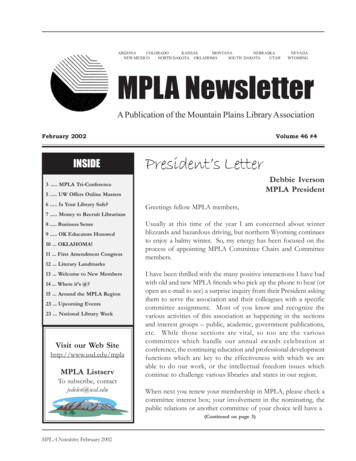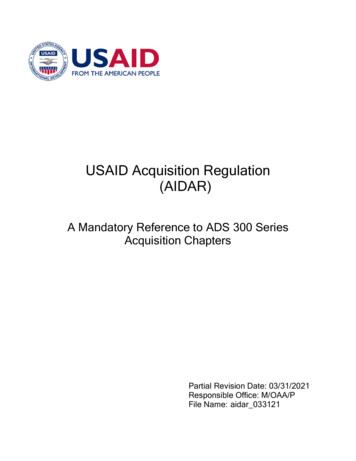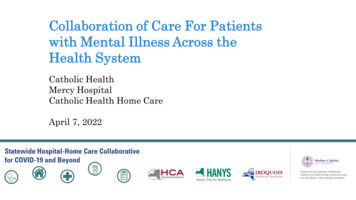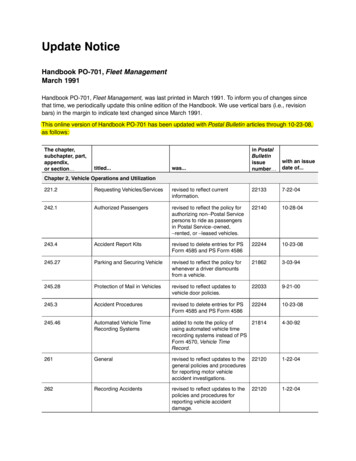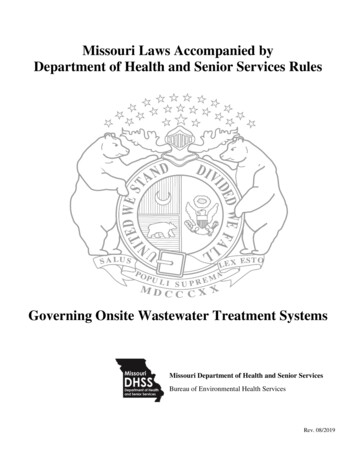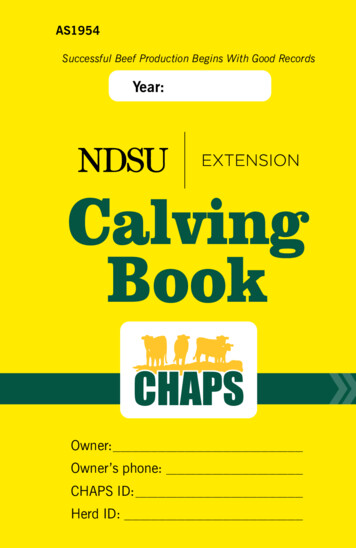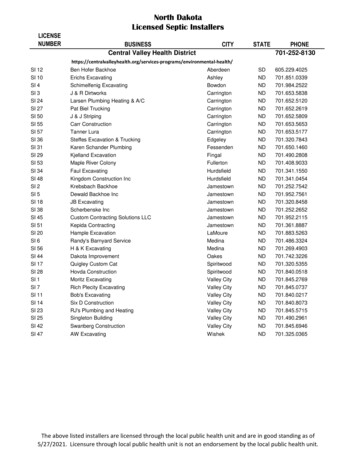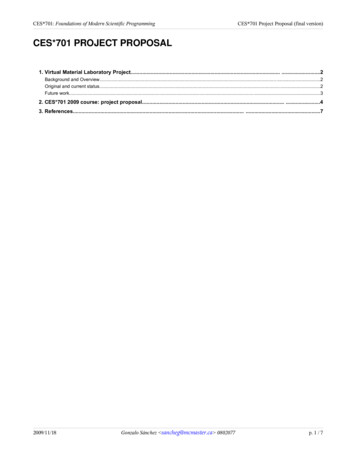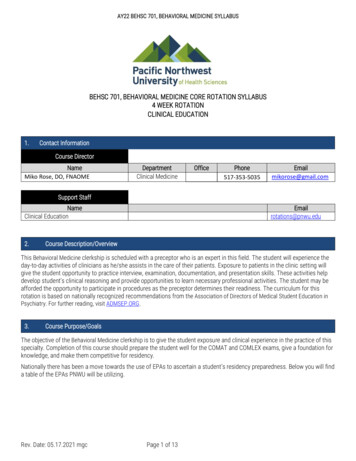
Transcription
AY22 BEHSC 701, BEHAVIORAL MEDICINE SYLLABUSBEHSC 701, BEHAVIORAL MEDICINE CORE ROTATION SYLLABUS4 WEEK ROTATIONCLINICAL EDUCATION1.Contact InformationCourse DirectorNameMiko Rose, DO, FNAOMEDepartmentClinical .comSupport StaffNameClinical Education2.Emailrotations@pnwu.eduCourse Description/OverviewThis Behavioral Medicine clerkship is scheduled with a preceptor who is an expert in this field. The student will experience theday-to-day activities of clinicians as he/she assists in the care of their patients. Exposure to patients in the clinic setting willgive the student opportunity to practice interview, examination, documentation, and presentation skills. These activities helpdevelop student’s clinical reasoning and provide opportunities to learn necessary professional activities. The student may beafforded the opportunity to participate in procedures as the preceptor determines their readiness. The curriculum for thisrotation is based on nationally recognized recommendations from the Association of Directors of Medical Student Education inPsychiatry. For further reading, visit ADMSEP.ORG.3.Course Purpose/GoalsThe objective of the Behavioral Medicine clerkship is to give the student exposure and clinical experience in the practice of thisspecialty. Completion of this course should prepare the student well for the COMAT and COMLEX exams, give a foundation forknowledge, and make them competitive for residency.Nationally there has been a move towards the use of EPAs to ascertain a student’s residency preparedness. Below you will finda table of the EPAs PNWU will be utilizing.Rev. Date: 05.17.2021 mgcPage 1 of 13
AY22 BEHSC 701, BEHAVIORAL MEDICINE SYLLABUS4.Entrustable Professional Activities (EPAs)EPAsDescription of ActivityDomains of CompetenceEPA 1: Gather a history and perform aphysical examination including anosteopathic structural exam asappropriate.Osteopathic medical students should be able toperform an accurate, complete, or focusedhistory and physical exam in a prioritized,organized manner without supervision and withrespect for the patient. The history and physicalexamination should be tailored to the clinicalsituation and specific patient encounter. Thisdata gathering and patient interaction activityserves as the basis for clinical work and as thebuilding block for patient evaluation andmanagement. Learners need to integrate thescientific foundations of medicine with clinicalreasoning skills to guide their informationgathering. EPA 2: Prioritize a differential diagnosisfollowing a clinical encounter(musculoskeletal considerations thatmay lead to somatic dysfunction.To be prepared for the first day of residency,osteopathic medical students in training needto be able to integrate patient data to formulatean assessment, developing a list of potentialdiagnoses that can be prioritized and lead toselection of a working diagnosis. Developing adifferential diagnosis is a dynamic andreflective process that requires continuousadaptation to avoid common errors of clinicalreasoning such as premature closure. This EPA describes the essential ability of theday one resident to select and interpretcommon diagnostic and screening tests* usingevidence-based and cost-effective principles asone approaches a patient in any setting EPA 3: Recommend and interpretcommon diagnostic and screening tests Rev. Date: 05.17.2021 mgcPage 2 of 13Patient CareKnowledge for PracticeInterpersonal andCommunication SkillsProfessionalismOsteopathic Principlesand Practice (OPP)Patient CareKnowledge for PracticePractice-BasedLearning andEnvironmentInterpersonal andCommunication SkillsPersonal andProfessionalDevelopmentOsteopathic Principlesand Practice (OPP)Recommend first-line,cost-effectivediagnosticEvaluation for a patientwith an acute orchronic commondisorder or as part ofroutine healthmaintenance.Provide a rationale forthe decision to orderthe test.Incorporate costawareness andprinciples of costeffectiveness and pre-
AY22 BEHSC 701, BEHAVIORAL MEDICINE SYLLABUS EPA 4: Enter and discuss orders,prescriptions, and applicable Osteopathictreatments.EPA 5: Document a clinical encounter inthe patient record.Rev. Date: 05.17.2021 mgcWriting safe and indicated orders isfundamental to a physician’s ability to prescribetherapies or interventions beneficial to patients.It is expected that Osteopathic medicalstudents will be able to do this without directsupervision when they matriculate to residency.Entering students will have a comprehensiveunderstanding of some but not necessarily allof the patient’s clinical problems for which theymust provide orders.They must also recognize their limitations andseek review and guidance for any orders andprescriptions they are expected to provide butfor which they do not understand the rationale.The expectation is that learners will be able toenter safe orders and prescriptions in a varietyof clinical settings (e.g., inpatient, ambulatory,urgent, or emergent care). Osteopathic medical students should be able toprovide accurate, focused, and context-specificdocumentation of either a clinical encounter inwritten or electronic formats. Performance ofthis EPA is predicated on the ability to obtaininformation through history, using both primaryand secondary sources, and physical exam in avariety of settings (e.g., office visit, admission,discharge summary, telephone call, and email). Page 3 of 13 test/post-test probability in developingdiagnostic plans.Interpret the results ofbasic diagnosticstudies (both lab andimaging); knowCommon lab values(e.g., electrolytes).Understand theimplications andurgency of an abnormalresult and seekassistance for interpretation as needed.Elicit and considerpatient preferences inmakingrecommendations.Clinical ExperiencesPresentationsCOMATPatient CareKnowledge for PracticePractice-BasedLearning andEnvironmentInterpersonal andCommunication SkillsProfessionalismOsteopathic Principlesand Practice (OPP)Patient CareInterpersonal andCommunication SkillsProfessionalismOsteopathic Principlesand Practice (OPP)
AY22 BEHSC 701, BEHAVIORAL MEDICINE SYLLABUSOsteopathic medical students should be able toconcisely present a summary of a clinicalencounter to one or more members of thehealth care team (including patients andfamilies) in order to achieve a sharedunderstanding of the patient’s currentcondition. A prerequisite for the ability toprovide an oral presentation is synthesis of theinformation, gathered into an accurateassessment of the patient’s current condition. EPA 7: Form clinical questions andretrieve evidence to advance patient care.It is crucial that students be able to identify keyclinical questions in caring for patients, identifyinformation resources, and retrieve informationand evidence that will be used to address thosequestions. Osteopathic medical studentsshould have basic skill in critiquing the qualityof the evidence and assessing applicability totheir patients and the clinical context.Underlying the skill set of practicing evidencebased medicine is the foundational knowledgean individual has and the self-awareness toidentify gaps and fill them. Knowledge for PracticePractice-BasedLearning andImprovementEPA 8: Give or receive a patient handoverto transition care responsibility.Effective and efficient handover communicationis critical for patient care. Handovercommunication ensures that patients continueto receive high-quality and safe care throughtransitions of responsibility from one healthcare team or practitioner to another. Handoversare also foundational to the success of manyother types of interprofessionalcommunication, including discharge from oneprovider to another and from one setting toanother. Handovers may occur betweensettings (e.g., hospitalist to PCP, pediatric toadult caregiver, discharges to lower-acuitysettings) or within settings (e.g., shift changes). Patient CarePractice-BasedLearning andEnvironmentInterpersonal andCommunication SkillsProfessionalismEffective teamwork is necessary to achieve theInstitute of Medicine competencies for carethat is safe, timely, effective, efficient, andequitable. Introduction to the roles,responsibilities, and contributions of individualteam members early in professionaldevelopment is critical to fully embracing thevalue that teamwork adds to patient careoutcomes. EPA 6: Provide an oral presentation of aclinical encounter.EPA 9: Collaborate as a member of aninterprofessional team.Rev. Date: 05.17.2021 mgcPage 4 of 13 Practice-BasedLearning andEnvironmentInterpersonal andCommunication SkillsProfessionalismPersonal andProfessionalDevelopmentInterpersonal andCommunication fessionalCollaboration
AY22 BEHSC 701, BEHAVIORAL MEDICINE SYLLABUSEPA 10: Recognize a patient requiringurgent or emergent care and initiateevaluation and management.The ability to promptly recognize a patient whorequires urgent or emergent care, initiateevaluation, and management, and seek help isessential for all physicians. New residents inparticular are often among the first respondersin an acute care setting, or the first to receivenotification of an abnormal lab or deteriorationin a patient’s status. Early recognition andintervention provide the greatest chance foroptimal outcomes in patient care. This EPAoften calls for simultaneously recognizing needand initiating a call for assistance. Patient CareInterpersonal andCommunication SkillsEPA 11: Obtain informed consent forprocedures/tests (under preceptorsupervision).All physicians must be able to perform patientcare interventions that require informedconsent. Osteopathic medical students may bein a position to obtain signatures for informedconsent for interventions, tests, or proceduresthey order or perform (e.g., immunizations,central lines, contrast and radiation exposures,blood transfusions, and OMM) after risks andbenefits have been explained by the physiciancaring for the patient. Patient CareInterpersonal andCommunication SkillsProfessionalismSystems-BasedPracticePersonal andProfessionalDevelopmentAll Osteopathic medical students mustdemonstrate competency in performing a fewcore procedures under supervision oncompletion of medical school in order toprovide basic patient care.These procedures include: Basic cardiopulmonary resuscitation (CPR) Bag and mask ventilation Venipuncture Inserting an intravenous line Osteopathic manipulative medicine (OMM) Preventing unnecessary morbidity and mortalityrequires health professionals to have both anunderstanding of systems and a commitmentto their improvement.This commitment must begin in the earlieststages of health professional education andtraining.Therefore, this EPA is critical to theprofessional formation of a physician and formsthe foundation for a lifelong commitment tosystems thinking and improvement. EPA 12: Perform general procedures of aphysician including applicableOsteopathic treatments.EPA 13: Identify system failures andcontribute to a culture of safety andimprovement. Patient CareInterpersonal andCommunication SkillsProfessionalismSystems-BasedPracticePersonal andProfessionalDevelopmentOsteopathic Principlesand Practice (OPP)Knowledge for PracticePractice-BasedLearning andEnvironmentInterpersonal andCommunication SkillsProfessionalismSystems-BasedPracticePrepared by the American Association of Colleges of Osteopathic Medicine, in conjunction with all U.S. Osteopathic Medical Schools. April 2016.Osteopathic Considerations for Core Entrustable Professional Activities (EPAs) for Entering Residency, 2016.5.Course Learning Objectives (NBOME)Rev. Date: 05.17.2021 mgcPage 5 of 13
AY22 BEHSC 701, BEHAVIORAL MEDICINE SYLLABUSCourse Learning ObjectivesMethods of AssessmentOsteopathic Practice and PrinciplesCandidates must be able to demonstrate knowledge ofosteopathic principles and practice, and todemonstrate and apply knowledge of somaticdysfunction diagnosis and Osteopathic ManipulativeTreatment in the clinical setting.Patient CareProvide patient-centered care that is culturallyresponsive, compassionate, and appropriate for theeffective treatment of illness and promotion of health.Preceptor and Regional AssistantDean Feedback and Evaluations,Case Logs, Case Presentations,Preceptor Evaluation, COMATClinical experiences,Didactics, CasePresentationsPreceptor and Regional AssistantDean Feedback and Evaluations,Case Logs, Case Presentations,Preceptor Evaluation, COMATClinical experiences,Didactics, CasePresentationsMedical KnowledgeDevelop a foundation of practical clinical knowledge onrotations while applying basic science knowledge.Develop skill in transitioning from passive to activelearning.Elements include an understanding and application ofthe evolving ethics of human subject research,osteopathic, biomedical, clinical, epidemiological,biomechanical, and cognate (e.g., epidemiological andsocial-behavioral) sciences in order to optimize patientcare.Clinical SkillsRecognize important roles of administrative personnel,nurses, and physicians in the delivery of health carethat contributes to a student’s professionaldevelopment. Further, refine patient history andphysical exam, and patient case presentations.Practice-Based Learning and ImprovementDemonstrate the ability to continuously evaluatepatient care practices, scientific evidence and personalbeliefs and biases as they relate to improving the careof patients and optimizing patient outcomes.Interpersonal and Communication SkillsDemonstrate the ability to consistently interactrespectfully, empathetically, and professionally withpatients, families, allied health care providers, staff andcolleagues, to optimize patient and researchoutcomes.ProfessionalismCultivate professional growth through interactions withall members of the health care organizationPreceptor and Regional AssistantDean Feedback and Evaluations,Case Logs, Case Presentations,Preceptor Evaluation, COMATClinical experiences,Didactics, CasePresentationsPreceptor and Regional AssistantDean Feedback and Evaluations,Case Logs, Case Presentations,Preceptor Evaluation, COMATClinical Experiences,Didactics, CasePresentationsPreceptor and Regional AssistantDean Feedback and Evaluations,Case Logs, Case Presentations,Preceptor Evaluation, COMATClinical Experiences,Didactics, CasePresentationsPreceptor and Regional AssistantDean Feedback and Evaluations,Case Logs, Case Presentations,Preceptor Evaluation, COMATClinical Experiences,Didactics, CasePresentationsPreceptor and Regional AssistantDean Feedback and Evaluations,Case Logs, Case Presentations,Preceptor Evaluation, COMATClinical Experiences,Didactics, CasePresentations, Skills LabsExhibit appropriate, professional behavior.Rev. Date: 05.17.2021 mgcPage 6 of 13Learning Activities
AY22 BEHSC 701, BEHAVIORAL MEDICINE SYLLABUSKnowledge for PracticeDevelop a foundation of knowledge in anatomy,physiology, pathophysiology, clinical medicine,osteopathic principles related to Primary Care, andclinical research. Students will be expected to applythis knowledge and demonstrate effective diagnosticand therapeutic reasoning skills related to thesesystems.Systems-Based PracticeEffectively utilize available health care systemresources to provide optimal health care to theindividual patient and local and global communities.Preceptor and Regional AssistantDean Feedback and Evaluations,Case Logs, Case Presentations,Preceptor Evaluation, COMATClinical Experiences,Didactics, CasePresentations, Skills LabsPreceptor and Regional AssistantDean Feedback and Evaluations,Case Logs, Case Presentations,Preceptor Evaluation, COMATClinical Experiences,Didactics, CasePresentations,Interprofessional Education(IPE)NBOME Fundamental Osteopathic Medical Competencies. June 20166.Course Schedule/CalendarPlease refer to the rotation schedule in E*Value. The rotation block is scheduled from Monday of the first day through Sundayof the last day. It is the expectation that the student will be available to assist the preceptor or designee whenever they areworking. This may include evening and weekend call time as assigned by the preceptor and may be up to 80 hours per week. Ifthe rotation involves shifts, the student will be expected to work at least four 10-12-hour shifts including a mixture of days,nights and weekends. The student will inform the RSA of their rotation schedule.7.Course FormatDidactics take place throughout your 3rd & 4th years and will be scheduled by the Regional Assistant Dean. Attendance ismandatory when rotating within the region. Exceptional circumstance involving clinical duties that require absence fromdidactics must be approved by the Regional Assistant Dean before didactics begin. When rotating in another PNWU region youshould participate in that region’s didactics. Please contact the host RSA if there are clinical duties that prevent yourattendance. Fourth year students rotating at audition rotations are expected to attend that institution’s morning or noonconferences with the residents as agreed to by their preceptor.8.Course LogisticsClinical rotations for PNWU are developed in a community-training model. Community training involves placing students in abusy physician’s practice, hospital-based experience, or residency program with learning objectives that direct the student’sfocus. The student is expected to be self-motivated to read about the cases seen and prepare for upcoming cases. Studentsshould avail themselves of learning opportunities, while taking advantage of clinical cases that present and further augmentwith reading and modules to complete the objectives. Professionalism means development of lifelong learning patterns andbehaviors. The texts and learning resources will provide information necessary for successfully studying in this rotation.Preceptors and residents may direct the student to their favorite texts or online resources.The Lange Series available on Access Medicine provides medical student level foundational knowledge in Core subjects.Modules for clerkship training are also available on Access Medicine.Case LogsThe cases listed below are the course objectives for this rotation. These objectives will prepare the student with a wide breadthof understanding of the common and life-threatening conditions related to this rotation.Rev. Date: 05.17.2021 mgcPage 7 of 13
AY22 BEHSC 701, BEHAVIORAL MEDICINE SYLLABUSThis rotation is a core, so students should focus on developing a basic understanding of the disease processes coupled withfurther honing of their presentation skills necessary for residency, including: Signs, symptoms and physical exam Differential diagnosis Basic Pathophysiology Diagnostic studies needed and their interpretation Initial treatmentLogs of the cases will be documented in eValue (see the Case Logs tab in eValue). Logs may be satisfied by seeing a patientwith the condition, completing a reading assignment on the condition, or completing an online module providing the student anunderstanding of the above concepts.When participating in patient care, the student may wish to briefly state information about a patient for future reference in the“Notes” section. For example: “38-year-old male with depression” or “42-year-old female, assisted in total abdominalhysterectomy”. If a reading is completed or a module is completed, then briefly comment in the “Notes” section the textbookutilized or the module completed.For core rotations, each case listed must be logged in eValue at least once in order for the case logs to be consideredcomplete for grading and honors. However, logging the total number of encounters participated in will better reflect thestudent’s rotation experience. The logs may be collated in a portfolio to showcase student work for residency interviews.Students should verify completed logs by running a summary report to assure all requirements were met and recordedsuccessfully. If a student wishes to be considered for honors, they must be able to verify logs were completed within 7 days bya time stamped report.CasesConditionDirect Patient CareADHDAdjustment DisordersAlcohol Use Disorder and SubstanceAbuse/Intoxication/Use DisordersAmnestic and related disordersAnxiety DisordersAutismsuggest put this outside of cases listCoping with Moral Distress in MedicineProfessionalism ModuleCortical SyndromesDanger to self or others assessmentDeliriumDementia and Cognitive ImpairmentsDisorders of Childhood and AdolescenceEating DisordersEpigeneticsRev. Date: 05.17.2021 mgcPage 8 of 13ObservationReading/Module
AY22 BEHSC 701, BEHAVIORAL MEDICINE SYLLABUSGeriatric DisordersImpulse Control DisordersMedical ethicsMood DisordersPain ManagementPersonality DisordersPhysician Patient BoundariesPsychiatric disorders secondary to generalmedical conditionsPsychotic DisordersSchizophreniaSexual DisordersSep line/section for : Gender DysphoriaSleep DisordersSomatoform, Factitious, and Pain DisordersSubstance-Induced Mood DisordersTrauma and Stress-Related DisordersTreatment complicationsSOAP NotesMastery of writing SOAP notes is an important skill for students to learn. Some of the purposes of SOAP notes include: Reflect the evolution of the physician’s thinking progress as a case unravels, differential diagnosis is created and afinal diagnosis surfacesCommunicate patient status and progress to others involved in careMaintain a record for future referenceDocument care for billing purposesProtect from liabilityFollow a verbal presentation formatVarious organizations have different institutional policies on who may access the electronic medical records (EMR) whichmay not provide students the opportunity to write notes in the legal record. When the institution allows access to the EMR, thestudent is expected to utilize the EMR as directed by their preceptor. Writing a SOAP note is an excellent exercise to organizethe information known about a patient, and will assist a student in their clinical presentation and reasoning. The studentshould be writing notes every day, either in the chart when permitted, or as a separate activity. Students should have theirpreceptor and/or Regional Assistant Dean review their SOAP notes and elicit feedback on their clinical reasoning.Students should learn the terminology utilized in the discipline, and the expectations of their preceptor for each SOAP notetype. Students should review the core SOAP note modules located on the third-year core clerkship SharePoint pages found inthe Medical Students EHR Documentation Training Module that discusses the documentation of a thorough history andphysical. Students should use the focused discipline note for a routine visit.Case PresentationsAn important clinical skill is communication with other members of the health care team through well-organized casepresentations. There are three basic types of case presentations:Rev. Date: 05.17.2021 mgcPage 9 of 13
AY22 BEHSC 701, BEHAVIORAL MEDICINE SYLLABUS Clinical Rounds/Office Presentationo Daily reports of patient progresso Briefly recap patient presentation and changes since last visito Takes several minutes and varies by specialty disciplinesMorning Reporto Students should be prepared to present their assigned patient’s overnight clinical status and labso Students should read about their cases and be able to discuss their cases.o Review of the patient presentation to preceptors, residents, and medical learnerso If presenting a teaching case – ask questions that stimulate creation of differential diagnoseso Be prepared to discuss salient teaching points and latest recommendations.o This process usually takes 10-15 minutesFormal Disease Processo 30-60 minutes presentation that begins with a case.o More in depth discussion of the disease process and treatment optionso Usually use a PowerPoint or Prezio Use this presentation format for the recorded presentation graduation requirement.Students should be presenting patients to their preceptor or resident on a daily basis. The structure of these reports shouldfollow the same format as the SOAP notes. Learning to present in a systematic way is an essential skill that develops withexperience and shows that the student has learned the basic communication of the health care team. The Regional AssistantDean will also be asking students to give case reports to judge their progress. Other members of the team will judge astudent’s medical knowledge and progression in clinical reasoning by the student’s skill in giving case presentations.9.Learning AssessmentFormative AssessmentsAssessmentRegional Assistant Dean ReviewsReview of Case Logs to ensure 100% completionEvaluation of Formal Presentation – Regional Assistant DeanMid-rotation Preceptor Review (if applicable)Preceptor Evaluation of Student Performance in Core CompetenciesPass/FailPass/FailPass/FailNot gradedPass/FailSummative AssessmentsAssessmentPreceptor Evaluation of Student PerformanceAttendance (any unexcused absence constitutes a fail)COMAT End of Service des for this course are Pass/Fail. All assessments must have a grade of “Pass” to pass a rotation. Any of the summativeassessments with a “Fail” will require remediation of the rotation. Students who have not completed the rotation satisfactorilywill be referred to Student Progress Committee for determination of remediation. Assessment10.Exam PolicyRev. Date: 05.17.2021 mgcPage 10 of 13
AY22 BEHSC 701, BEHAVIORAL MEDICINE SYLLABUSThird yearEach third-year core rotation, except Primary Care Core, will be evaluated by a COMAT end of service examination. The COMATis a national standardized examination produced by NBOME to ensure all students have met course objectives. A student mustfirst pass the accompanying TrueLearn pre-assessment to schedule their COMAT. A passing score for required COMATexaminations is a graduation requirement. Refer to the Student Handbook for more details.Fourth yearNo end of service examinations are required by PNWU during electives. Students in their fourth year should be preparing forCOMLEX 2 CE during their rotations.11.Course Textbooks & SuppliesRequired TextbooksTitle/ISBNCURRENT Diagnosis & Treatment: PsychiatryAuthor/Publisher/EditionMichael H. Ebert et al., McGraw-Hill, 3rd edition.Available on Access Medicine.ISBN: 9780071754422Suggested Additional l D. Feldman, et al, McGraw-Hill, 5th edition. Availableon Access MedicineBehavioral Medicine: A Guide for Clinical PracticeISBN: 9781260142686Case Files: PsychiatryEugene C. Toy and Debra L. Klamen, McGraw-Hill, 6th editionAvailable on AccessMedicine Case Files CollectionISBN: 9781260468731CURRENT Medical Diagnosis and Treatment 2021Maxine A. Papadakis, MD, et al., McGraw-Hill.Available on Access MedicineISBN: 978-1-26-046986-8Diagnostic and Statistical Manual of Mental Disorders, DSM-5.ISBN: 0890425558American Psychiatric Association, 2013, 5th editionDesk Reference to the Diagnostic Criteria from DSM-5American Psychiatric Association, 2015, 5th editionISBN: 9780890425565Foundations of Osteopathic MedicineMichael A. Seffinger (editor), Lippincott Williams & Wilkins,4th edition. Available on LWW Health LibraryISBN: 9781496368324Harrison’s Principles of Internal MedicineISBN: 9781259644030Dan Longo et al. (editors), McGraw-Hill. 20th edition.Available on Access MedicineKaplan & Sadock’s Synopsis of PsychiatryRobert Joseph Boland, editor. Wolters Kluwer Medical, 2022.12th editionMerck Manualhttp://www.merckmanuals.comMerriam-Webster Medical rescriber's Guide: Stahl's Essential PsychopharmacologyStephen M. Stahl, Cambridge University Press, 6th editionISBN: 9781975145569ISBN: 9781316618134The Washington Manual of Medical TherapeuticsZachary Crees, et al., Lippincott Williams & Wilkins, 36thedition. Available on OvidISBN: 9781975113483Rev. Date: 05.17.2021 mgcPage 11 of 13
AY22 BEHSC 701, BEHAVIORAL MEDICINE SYLLABUSThe Massachusetts General Hospital/McLean Hospital ResidencyHandbook of PsychiatryISBN: 978078179504312.James Niels Rosenquist, Editor. Wolters Kluwer Health,2010. Available on EBSCOhosthttps://proxy.pnwu.org/login?url https://search.ebscohost.com/login.aspx?direct true&scope site&db nlebk&db nlabk&AN 2018335Student Roles and ResponsibilitiesLinks to current Student Catalog and Student a. Student ProfessionalismProfessional behavior is expected at all times during this course. It is important that students learn to discuss topicsof a sensitive nature in a caring and professional manner. Use of cell phones or texting during class is prohibited. Forfurther clarification of student professionalism expectations, see Student Catalog.b. Honor CodeThe highest standards of academic honesty are required of all PNWU-COM students at all times. It is expected that noPNWU student will be dishonest in any way, or give the impression of dishonest behavior, nor will PNWU studentstolerate dishonesty in others. Disciplinary action may occur as a result of failure to comply with these standards.c. Academic SupportStudents in need of peer tutorial assistance are directed to contact Rica Amity, PhD, Learning Skills Specialist(ramity@pnwu.edu). Though the Assessment Department strives to accommodate all tutorial, assistance requests,priority will be given to students who demonstrate need based on their academic performance.The most successful students will practice the following behaviors:First day Share contact information with the preceptor and learn what expectations of communication are.Ensure the preceptor has a copy of the PNWU syllabus for the course.Ask about the regular schedule, on call expectations and notify the preceptor if there are any excused absence days(i.e. COMLEX exams).Find out where personal item
AY22 BEHSC 701, BEHAVIORAL MEDICINE SYLLABUS Rev. Date: 05.17.2021 mgc Page 1 of 13 BEHSC 701, BEHAVIORAL MEDICINE CORE ROTATION SYLLABUS 4 WEEK ROTATION CLINICAL EDUCATION 1. Contact Information Course Director Name Department Office Phone Email Miko Rose, DO, FNAOME Clinical Medicine 517 -353 5035 mikorose@gmail.com
